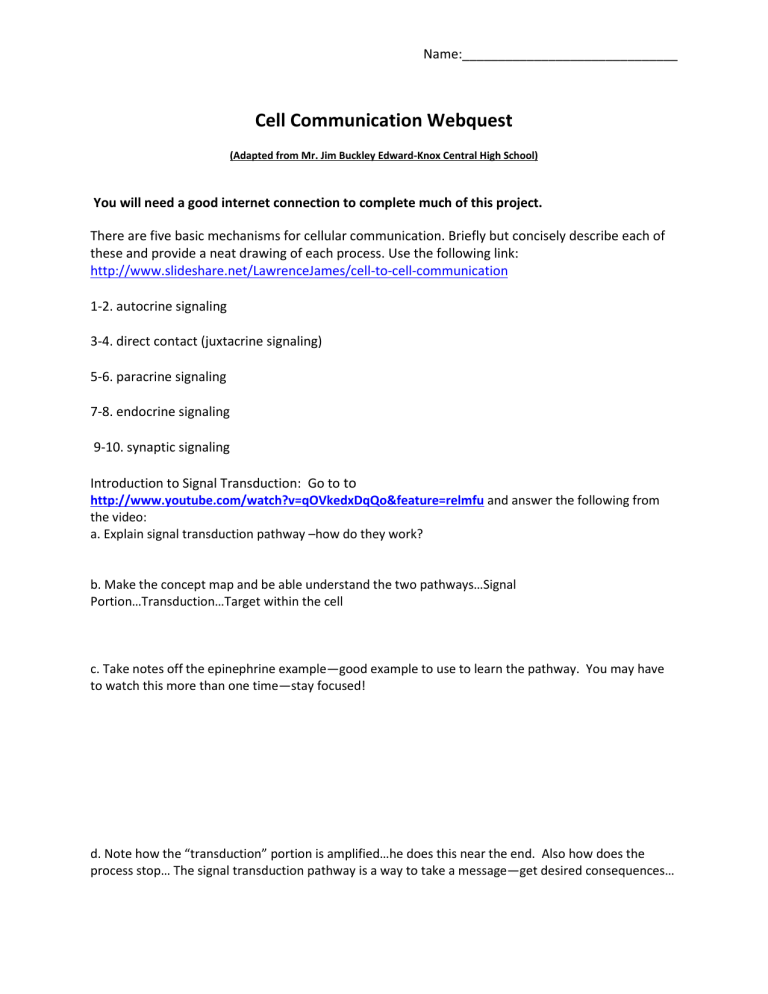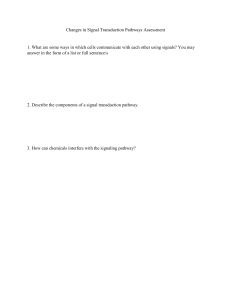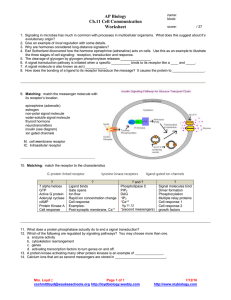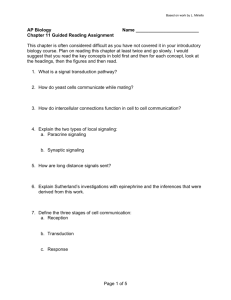
Name:______________________________ Cell Communication Webquest (Adapted from Mr. Jim Buckley Edward-Knox Central High School) You will need a good internet connection to complete much of this project. There are five basic mechanisms for cellular communication. Briefly but concisely describe each of these and provide a neat drawing of each process. Use the following link: http://www.slideshare.net/LawrenceJames/cell-to-cell-communication 1-2. autocrine signaling 3-4. direct contact (juxtacrine signaling) 5-6. paracrine signaling 7-8. endocrine signaling 9-10. synaptic signaling Introduction to Signal Transduction: Go to to http://www.youtube.com/watch?v=qOVkedxDqQo&feature=relmfu and answer the following from the video: a. Explain signal transduction pathway –how do they work? b. Make the concept map and be able understand the two pathways…Signal Portion…Transduction…Target within the cell c. Take notes off the epinephrine example—good example to use to learn the pathway. You may have to watch this more than one time—stay focused! d. Note how the “transduction” portion is amplified…he does this near the end. Also how does the process stop… The signal transduction pathway is a way to take a message—get desired consequences… View the cell communication animation at the following URL and use this to answer the following questions. http://www.phschool.com/science/biology_place/biocoach/biomembrane2/surface.html 11. What is a receptor? 12. What is signal transduction? View the cell communication animation at the following URL and use this to answer the following questions. http://media.pearsoncmg.com/bc/bc_campbell_biology_7/media/interactivemedia/activities/lo ad.html?11&A 13. What are the three stages in the cell signaling process? 14. What is a ligand? 15. Why does the ligand have to fit with the receptor molecule? 16. Why does signal transduction often involve a change in the shape of the receptor? 17. List three cellular responses that signal transduction can produce. View the cell communication animation at the following URL and use this to answer the following questions. http://media.pearsoncmg.com/bc/bc_campbell_biology_7/media/interactivemedia/activities/lo ad.html?11&B 18. How do most signal molecules act on target cells? 19. List four different kinds of receptors in target cells. COON 2019 Page 2 ** Click on the G-protein linked receptor in the animation. Then click on the correct signal molecule to activate the G-protein-linked receptor shown. 20. Discuss at least two events involved in causing the change in enzyme activity once the G-protein linked receptor is activated. ** Click on the receptor tyrosine kinase in the animation. Then click on the correct signal molecule to activate the receptor tyrosine kinase shown. 21. How does the bonding of the signal molecule to the receptor tyrosine kinase lead to the activation tyrosine-kinase enzymes? 22. How does the activated receptor tyrosine kinase trigger several different effects within the cell? ** Click on the ion channel receptor in the animation. Then click on the correct signal molecule to activate the ion channel receptor shown. 23. What are ligand gated ion channels? 24. Explain how signal proteins can activate ion channel proteins. ** Click on the intracellular receptor Then click on the correct signal molecule to activate the intracellular receptor shown. 25. Where are intracellular receptors located? 26. List two examples of steroid hormones that act on intracellular receptors. 27. Explain why nonpolar molecules are able to pass through the plasma membrane to bind to intracellular receptors. (thought question) 28. Explain how steroids cause changes inside a cell. COON 2019 Page 3 View the cell communication animation at the following URL and use this to answer the following questions. http://media.pearsoncmg.com/bc/bc_campbell_biology_7/media/interactivemedia/activities/lo ad.html?11&C 29. What are signal transduction pathways? 30. List two things signal transduction pathways allow for. 31. What are second messengers? 32. List 2 important second messenger molecules. 33. What is a protein kinase? 34. Discuss how protein kinases function to produce signal amplification in a cell. COON 2019 Page 4 ** Note, the following is a large file which should only be viewed on a higher speed internet connection. Now view the Cell Communication Video Podcast and answer the following http://www.youtube.com/watch?v=xnGXItWrJ3k 35. List two examples of cell to cell communication. 36. What is an antigen? 37. What does an APC or antigen presenting cell do? 38. How does the T-helper cell get activated? 39. Identify two kinds of cells that T-helper cells in turn activate. 40. How do the previous sequence of events (addressed in questions 36-39) compare to a post-it note? 41. Why are local regulators like neurotransmitters like e-mail? 42. Explain why hormones are like facebook status posts. COON 2019 Page 5



